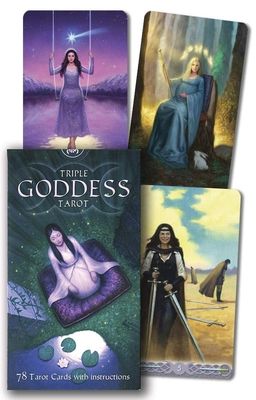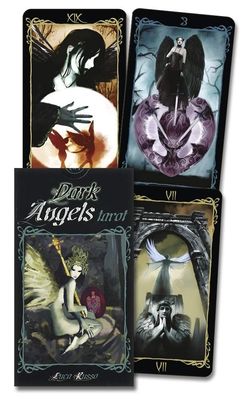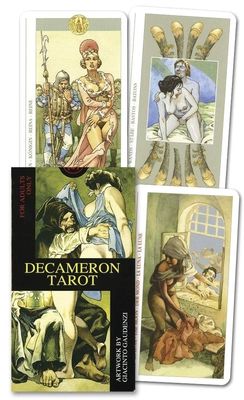Witchcraft supplies and wicca supplies online from one of the USA's BEST pagan stores! WINTER SALE NOW ON! USE COUPON CODE "DARKARTES" FOR 20% OFF SITEWIDE!!!
NECRONOMICON TAROT (78 cards, book & black organdy bag) BOX SET
$29.90
The Necronomicon Tarot brings the phantasmagoric desert wanderings of Alhazred to life in a stunningly deck and companion book. 78 captivating illustrations by fantasy artist A. Stokes capture the mythic and monstrous world of Tyson's Necronomicon.
In stock: 1 available
Product Details
UPC: 9780738710860
Brand: Llewellyn Publications
Tags: Fortune Telling,Tarot Deck,divination
BOX SET!
Grim Agents of Cosmic Forces...
In the early twentieth century, legendary horror writer H.P. Lovecraft described an ancient tome as "the unmentionable Necronomicon of the mad Arab Abdul Alhazred...a book which I had never seen, but of which I had heard monstrous things whispered." In the early twenty-first century, best-selling author Donald Tyson wove the myriad rumors and whispers of Lovecraft's dread grimoire into the epic fantasy novels Necronomicon and Alhazred. Intended as a trilogy, this tarot completes Tyson's formidable work.
The Necronomicon Tarot brings the phantasmagoric desert wanderings of Alhazred to life in a stunningly visceral deck and companion book. Seventy-eight captivating illustrations by fantasy artist Anne Stokes capture the mythic and monstrous world of Tyson's Necronomicon while remaining true to the underlying structure and tradition of tarot. Prepare to enter a world where the accursed and tormented poet wanders in search of the greatest and darkest magic―divination with the dead.
This kit includes 78-card tarot deck and 240-page companion tarot book.
REVIEW
5.0 out of 5 stars The Stars Are Right
Reviewed in the United States on August 3, 2007
That is not dead which can eternal lie,
And with strange eons even death may die.
-- Necronomicon
The Necronomicon Tarot by Donald Tyson, illustrated by Anne Stokes, is a brilliant adaptation of H.P. Lovecraft's work to the Tarot format. For those not familiar with HPL, he was an early 20th century pulp fiction writer whose work focused on the other-worldly horrors of ancient magic and forgotten civilizations. He created the Necronomicon as a literary device, an imaginary tome of ancient magic upon which much of his hideous mythology was based. Tyson himself has continued that lineage with two novels and this Tarot, the third in his trilogy. The Tarot comes in a boxed book and deck set, together with a mosquito-net style bag. Given the subject matter, I was a little disappointed that it did not include a shrunken head, or at the very least some dusty old bones, but I suppose there are postal regulations to contend with.
The deck itself is of standard size, and the usual Tarot format of 22 Major Arcana cards, and a Minor Arcana in four suits of 10 plus four court cards. The art work is vivid and brightly colored, set against a black background that makes the cards almost glow. The design of the Major Arcana itself is roughly traditional (whatever that really means), with the substitutions one would expect for the theme. Most of them will be immediately recognized by students of the genre: Nyarlathotep is the Magician, Dagon is the Hierophant, the Hounds of Leng haunt the Moon, and of course Great Cthulhu himself appears as the Devil. Each suit of the Minor Arcana is based on a particular theme, and for the most part, the cards are descriptively illustrated, and follow the Golden Dawn pattern. The Wands, which we are told represent Fire, somewhat surprisingly concern themselves with Atlantis, and Deep Ones make frequent appearances. The Cups reflect an Egyptian theme, tracing the progress of an acolyte of Bast. The Swords concern themselves with betrayal, distrust and death, while the Disks chronicle the adventures, and eventual success, of a necromancer.
The theme immediately invites a comparison with the H. P. Lovecraft Tarot, by Friedman and Hutchinson, published by Mythos Books, and now sadly out of print. Its first edition was cast in bluish-green tones, and its second edition appeared in sepia, while the Necronomicon Tarot is in full, bright colors. The HPL Tarot provides a more thorough illustration of Lovecraft's works -- it is very much a Necronomicon in itself, which might, to those not familiar with Lovecraft's work, make it a little difficult to use as a Tarot. The Necronomicon Tarot, on the other hand, is immediately recognizable as a Tarot deck. While a familiarity with Lovecraft's work would certainly add to one's appreciation of the deck, it should be easy to use by those familiar with the Tarot in general, and, thanks to the detailed book that accompanies it, by those with an interest in the theme who are just beginning their study of the Tarot.
The book, "Secrets of the Necronomicon," is very well written, and would be very helpful to those not familiar with the work of Lovecraft, or with the Tarot itself. It includes chapters on the Necronomicon and its history, the Cthulhu Mythos, and Correspondences, which discusses the Tarot, and specifically its relationship to the Golden Dawn. There are detailed black-and-white illustrations, descriptions, and suggested divinatory meanings for each card, and finally a suggested layout for reading. The divinatory meanings roughly follow the GD standard, though there are occasional differences. If you don't happen to like the GD interpretations, you can focus more on using the card's description as a starting point for your own imagination and understanding of the card.
And there is a lot to imagine here. As Tyson points out, the Necronomicon itself is made out of the stuff of dreams, not out of wood pulp and glue. Its roots are deep within the unconscious, and its "reality" is in its ability to bring forth things that are hidden to ordinary waking consciousness. As such, it is a theme well suited to the Tarot, which is itself a product of the collective unconscious.
But what is this all about? Why all the excitement over a book that does not exist, over monsters that were invented by a pulp writer in the early 20th century? No one could take all this stuff seriously! After all, no one believes in metaphysical Evil anymore; it's evil with a small "e." Human frailty and corruption, not monsters and devils. Right? Maybe. But, methinks, thou whistleth a bit too loudly in the graveyard...
Nietzsche used the word "blinken" to describe a kind of narrow-sighted, closed-mindedness that refuses to recognize anything other than what makes your own world comfortable for you. It's easy to say there is no "Evil," if you have never faced it. It's easy to say Tarot cards are rubbish, if you have no talent for reading them. It's easy to walk through the graveyard at night, if you don't look behind yourself. And it's easy to ridicule what others believe, until your own little world falls apart.
Then, like Pandora's box, the collective unconscious opens wide, and every horror that has stalked the human race since before recorded history lunges forth with vengeance. The stars are right, and that which became Tiamat to the ancients, and Cthulhu in the mind of Lovecraft, rises from the sea to shred what remains of your "reality." Madness, yes, but "reality" too. More drugs? Drugs can alter your brain so you don't see what is socially unacceptable, but they do not change the "reality" of what lies beyond the blinken.
Therein lies the fascination of the Necronomicon. Sure, it's a myth, but that is what a myth is -- a map of the world that lies beyond immediate experience, a signpost in the twilight zone that lies beyond the blinken. Someone else's experience of a world as yet unknown; and whether imaginary or historical, it is just as valid. And this is the value of the Necronomicon Tarot, along with other "dark" tarots, like the Bosch and the Gothic -- they are images of what lies in the collective unconscious, imaginary and at the same time very real. They speak to, and listen to, a part of the mind connected with the primal origins of humanity, and perhaps with the forces out of which humanity arose. They are gateways to a "reality" that we don't ordinarily see -- the stuff of which dreams and visions are made -- and they are ways of getting beyond the intellectual, moral, and spiritual "blinken" of modern culture.
Save this product for later
NECRONOMICON TAROT (78 cards, book & black organdy bag) BOX SET
You May Also Like

TRIPLE GODDESS TAROT (78-card deck & instruction booklet)
The lush artwork perfectly captures the deep magic of the feminine divine. Following the energies of the phases of the moon, this deck provides insights into the cyclical nature of the challenges and uncertainties that dawn in our lives.
TRIPLE GODDESS TAROT (78-card deck & instruction booklet)
$23.95

MUCHA TAROT (78-card deck, instruction booklet & box with removable cover)
An extraordinary tribute to art nouveau pioneer Alphonse Mucha, this deck embraces the fresh beauty of the dawning of the twentieth century along with the eternal wisdom and understanding of the tarot.
MUCHA TAROT (78-card deck, instruction booklet & box with removable cover)
$26.95
Display prices in:USD





